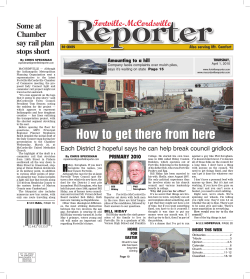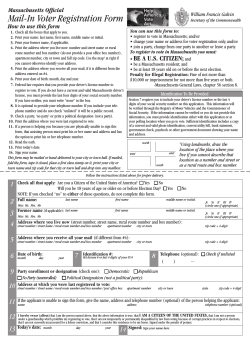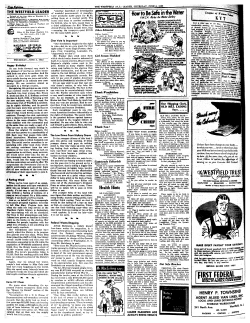
DRAFT 2 WSTC Response to Plan: MK Paper
DRAFT 2 WSTC Response to Plan: MK Paper 1. WSTC is surprised to see this consultation document in view of the fact that the Core Strategy was completed and approved as recently as 2013. That Strategy, which followed extensive local consultation and an exhaustive Public Inquiry, sets out the future of the Borough until 2026. Furthermore the various Neighbourhood Plans which are underway reflect the provisions of the Core Strategy; the provisions of any adopted Neighbourhood Plans must also be incorporated in Plan:MK. 2. Notwithstanding the “Duty to Cooperate” requirement introduced in the recent localism legislation the Town Council is also surprised to see that the Plan:MK document contains a number of references to the South Midlands Area and makes a number of policy suggestions on a sub-regional basis rather than a Borough basis. Effectively this is a return to the ill-fated South East Regional Plan which was withdrawn in 2010 prior to the Government’s publications of its localism agenda. The Town Council believes that this is a retrograde step which will lead to arguments between local authorities and an unnecessary increase in bureaucracy. 3. However the Town Council recognises that it will be useful to review the policies in the Core Strategy at some point and to provide additional policies where necessary. It is also noted that Plan:MK will run until 2031 ie five years later than the Core Strategy. 4. In view of this background the Town Council believes that there should be no deviation from the Vision, Aims and policies set out in the Core Strategy unless it can be shown that such policies will not hold true until 2031. The Site Allocations Plan currently out to consultation may provide some of the additional capacity for development beyond the proposals in the Core Strategy should that be deemed necessary. 5. The Town Council considers that it is far too early to re-examine the core questions posed in the Plan:MK document and that such a re-examination should await the completion of the East and West flank developments and at least part of the SLA development in the East (currently in the planning stage). The impact of all this growth must be assessed before any suggestions of yet more development (particularly in the South East) is even considered. 6. Furthermore current consideration is being given to the electrification and enhancement of the East-West rail line. Any changes will have a substantial bearing on the development of the South East of Milton Keynes and it is therefore premature to propose any further development in this area until the outcome of the Network Rail study is known. 7. The Town Council’s specific comments on the proposals set out in the Plan:MK Consultation Document are set out below. Vision and Development Strategy Question 2 Content of Vision (Page 11) 8. The Town Council can see no reason to change the Vision set out in the Core Strategy Question 3 Land Requirements (Page 21) 9. Extensions of development into yet more green spaces around the current settlements should not be considered until all those areas within the urban area with outline permissions are developed, and any regeneration of poorly used industrial sites has taken place. Question 4 Urban/Rural Split (Page 22) 10. There should be no change in the proposed split. However development priority should be given to completing the undeveloped urban sites first. (See above) Question 5 Urban Extensions (Page 25) and Map 11. There seems to be an assumption behind the Plan that there will be no definitive size for Milton Keynes and that the city will just continue to grow in the future. The Town Council can see no justification for this approach. The original plan for Milton Keynes envisaged a specific size and the supporting infrastructure was planned on this basis; while this size may now be considered inappropriate there needs to be a public debate on the most appropriate size for Milton Keynes. The Woburn Sands Town Council can see no justification for the endless expansion of Milton Keynes – such a policy would ruin the smaller and pre-existing settlements such as Woburn Sands. 9 There therefore seems no reason to plan for the extension of Milton Keynes into the red areas shown on the map (ie the areas outside the Borough). These areas are not even inside the Borough and, while there might be reasons to open negotiations with adjoining authorities on minor changes to the boundary (such as the boundary between Milton Keynes and Central Bedfordshire in Woburn Sands), they should not be considered for expansion. 12. The blue areas surrounding Woburn Sands on the map were rejected for development by the Inspector considering the Core Strategy; more specifically the blue area between Woburn Sands and Bow Brickhill which lies within the parish of Woburn Sands is excluded from development in the Woburn Sands Neighbourhood Plan since it lies outside the current development boundary (Policy WS5). The Town Council can see no justification for either of these areas to be identified for development. Question 6 Employment Sites (Page 26) 13. The Town Council would support the proposal that some undeveloped sites allocated for employment should be re-designated for housing. This would be a sustainable approach in that services are available in those areas, and would relieve the pressure to develop rural areas. It is worth considering whether to introduce some relaxation of the design guidelines to enable the use of quick construction methods such as the use of prefabricated materials. This would expedite the process by making it less expensive for start-up businesses. Question 7 Regeneration (Page 27) 14. See above. Question 8 Standalone Settlements (Page 28) 15. The town Council would not support the creation of any further standalone settlements. Question 9 Wider Housing Market Area (Page 29) 16. While it is clearly useful for adjoining authorities to discuss their housing plans in order to ensure that infrastructure provision is coordinated there is no reason why the housing requirements of any one authority should be provided by another. Question 10 Rural Settlement Hierarchy (Page 30) 17. Woburn Sands is currently meeting more than its fair share of the rural housing requirement identified in the Core Strategy. The Town Council does not accept the longer term housing target suggested in the Plan:MK document (see response to Question 1 of the Growth in Housing Topic Paper below). There should be no further growth in the parish until such time as the present developments in Parklands and the Greens site have been completed; this policy is incorporated in the Neighbourhood Plan which was endorsed by 89% of the residents voting on the Plan. 18. There is no reason why there should not be a dispersed pattern of housing throughout the rural area provided there is adequate local infrastructure. Questions 11 and 12 Employment Allocations and Employment Land (Pages 32 and 33) 19. See answer to Question 6. Question 13 Open Space (Page 35) 20. Extension to the linear park should form part of any new strategy with no infilling of the existing areas. Question 14 Environmental Constraints (Page 35) 21. Landscape views should be considered particularly where thes lead to surrounding AOBs or from higher points (eg Campbell Park). Question 15 Transport (Page 38) 22. The concept of the grid road system should be carried forward into any new developments and the City Street concept as in the Eastern flank should not be repeated elsewhere. The grid road system is a key characteristic of Milton Keynes and deviation from it should never again be allowed. The redway system should also extend into all new developments. Question 16 Retail and Leisure (Page 40) 23. Local centres should remain precisely that ie there should be an appropriate mix of convenience stores; larger stores should only be located in major retail centres such as Kingston. 24. The retention and enhancement of leisure opportunities in the older settlements should be a high priority. Question 17 Flexibility of Uses (Page 41) 25. The Town Council would favour a site specific approach for considering flexibility of use. Growth in Housing Question 1 SHMA and Housing Need (Page 9) 26. The Town Council is not convinced by the methodology put forward. The growth of any area is determined by individuals considering the attractiveness of that area in terms of employment, housing, schooling etc. There is a great danger in “overplanning” from above. The sub-regional approach suggested in the Plan:MK document appears to be based on aggregating optimistic and untested trends rather than on a more considered approach taking into account the skills and current infrastructure of the area. 27. Milton Keynes has an excellent track record over the last 25 years of growing employment and housing; in general terms the necessary infrastructure has been grown to match these trends. As a result Milton Keynes is an extremely sustainable Borough. There is no reason why these trends should not continue in the foreseeable future and the Town Council suggests that these provide a more realistic basis for planning rather than setting hopeful targets. 28. However Milton Keynes cannot, and should not, continue to grow ad infinitum. The community must remain balanced and sustainable which will not be possible under the scenario hinted at in the Plan:MK document. The Town Council strongly recommends that MKC should sponsor a debate amongst all sectors of the community to assess what could be regarded as an optimum size given the achievements to date of Milton Keynes and the present level of infrastructure. An optimum timescale, bearing in mind the land currently available and the rate of construction (see response to Question 2 below), could then be established. While such an approach cannot be prescriptive or rigidly enforced it will provide a long term objective. 29. Since the SHMA figure has already been objectively assessed the Town Council sees no reason to adjust the figure of 1650pa homes upwards. Question 2 Market Signals (Page 12) 30. Figure 2 on page 10 gives the actual rate of housing growth over the last ten years. The number of completions has remained very consistent over the period despite the changing economic situation. In its whole existence Milton Keynes has only rarely exceeded 2000 completions per annum despite the increasing number of planning approvals. There seems no reason why the annual rate of completions should suddenly improve on this figure. Question 3 Need from Other Areas (Page 22) 31. As indicated above the Town Council believes that every planning authority should plan to build sufficient houses to meet their own needs. Question 8 Housing Mix (Page 30) 32. The Town council sees no reason to deviate from the original plans for housing mix on all developments. Where such a mix is not currently available (as may be the case in some of the older pre-existing settlements) the character and need of that specific area should be taken into account. Rural Issues Question 9 Settlement Boundaries (Page 28) 33. Settlement boundaries should be a matter for the residents of the settlement unless there is an over-riding requirement identified by the Borough. The residents of Woburn Sands were clear in their support for the existing boundaries. The Woburn Sands’ experience of the current development of the town shows that there is a finite limit to the scale of development in a settlement; this limit is determined by such elements as the retail provision, education, and medical services. Transport and Travel Question 1 Walking and Cycling (Page 15) 34. The redway system should be extended as far as possible. Note. Its use could be increased by ensuring that the surface maintenance work is carried out effectively and, in places, an improvement in lighting would be beneficial. A map of the redways would also assist further usage. Question 5 Rail (Page 20) 35. Any suggestion of increasing development around Woburn Sands because of East-West rail enhancements should be vigorously opposed. The adopted Woburn Sands Neighbourhood Plan gives an agreed development framework for the area and the settlement will lose all its identity and character if forced to expand into what little green area currently distinguishes the town from the spread of Milton Keynes. The infrastructure of Woburn sands is already under pressure and there is no realistic prospect for its expansion. Question 8 Roads (Page 22) 36. The principle of the grid road system should be maintained throughout Milton Keynes and the mistake of the City Street concept should not be replicated. Conclusion 37. The Woburn Sands Town Council has restricted its comments to those specific questions on which it feels particularly competent to comment. Individual residents may wish to comment on other topics. 38. The Council is however particularly concerned at the apparent approach to completely re-write the Core Strategy and the work which went into the preparation of that strategy. MKC should concentrate on extending the policies set out in the Core Strategy and initiating a debate amongst residents and stakeholders on the optimum long term vision, size and scale of Milton Keynes. 39. Any future expansion must be economically, socially and environmentally sustainable and contribute to the original concepts of Milton Keynes which have been instrumental in its success to date. 40. Growth should be accommodated within existing boundaries based on a good system of public transport and cycleways 41. Indefinite outward expansion is not a realistic goal. If it appears that demand is sufficient then it would be more acceptable to plan for increased density within existing boundaries rather than extending the boundaries. November 2014
© Copyright 2025












